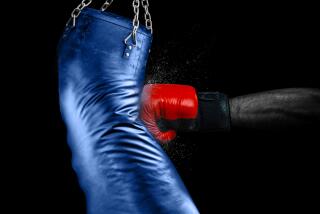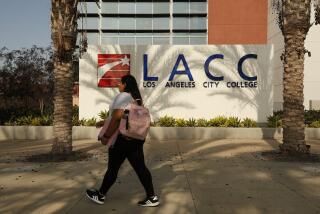State hustled to succeed
California first marched itself into the big, bruising realm of higher education with a mortarboard on its head and a chip on its shoulder.
For all the braggadocio of 19th century California, for all the superlatives churned out to entice tourists and settlers with tales of unspoiled charms and easy bounty, California also realized its sons and daughters would need to be able to spell “braggadocio,” and a lot more.
Even as the state boasted, it also looked over its shoulder, anxious to prove itself the equal of the East -- and that shoulder bore the boulder-sized chip that invariably showed up when it came to higher education.
In 1893, when Chicago University announced that it would be offering extension courses, The Times tried to trump that with the announcement that the paper had “a proposition which makes every home a ‘university extension center’ -- tuition for ten cents a day, to buy a 25-volume set of the Encyclopedia Britannica.”
Claremont, the multiple college town, became the city of “trees and PhDs” by virtue of a 19th century Street Tree Committee and the ministers and professors hired away from the Ivy League latitudes. The names of those schools, like Yale and Amherst, still showed up on Claremont street signs -- either out of homesickness, or wishful thinking.
Even into the 20th century, the great distance between the coasts and the then-uneven academic playing field gave California students an exotic quality in the regard of their Eastern classmates.
In the fall of 1954, a San Gabriel Valley native stepped off the train at Williams College in Massachusetts, to be met personally by the college president. He was introduced everywhere as “the student from California.” Classmates inquired whether it had been safe to cross the desert. One young woman asked whether he’d encountered “Indian problems.”
The other coast did have one bang-up head start: Harvard had been graduating students for more than 200 years before California’s first college -- Santa Clara College, outgrowth of missions -- handed out its first diploma in 1857, to Thomas I. Bergin.
(Some people cite California Wesleyan College as first, since it won its charter in 1851, the year Santa Clara began offering classes. Some have made a case for Hartnell College, a Salinas community college, which was mentioned in a regional census of 1835, but whose students may then have been of grade-school rather than college age.)
In Los Angeles, the college boom paralleled the real estate boom, both born of the same genteel hustle to succeed. In the 1880s and 1890s, colleges were born, flourished or withered.
Like Santa Clara, most began with some religious affiliation, but Protestant -- Methodist, Presbyterian, Congregationalist, in keeping with the new Midwestern Yankee population. These church affiliations would be severed as the schools, including USC and Occidental College, prospered. When you came down to it, the colleges had to be kick-started by religious groups; government was incidental to the concerns of Southern California’s businessmen, who set policy for the region almost as blithely as they set it for their companies. (A co-founder of Union Oil also founded Biola College, the name being an acronym for Bible Institute of Los Angeles.)
Thus, many of the region’s early colleges were private and haphazardly endowed; not until the California master plan of 1960 did a coherent system of public universities and colleges take form.
Happily, the further education of this baby burg commanded ecumenical efforts: Methodist USC was midwifed into being by the generosities of a Jewish banker, a Catholic former California governor, and a Protestant horticulturist who also donated the land for L.A.’s first high school and college: St. Vincent’s.
The school opened its doors in 1865 and laid the foundation for present-day Loyola Marymount University. (Like all good Angelenos, St. Vincent’s-LMU has followed the real estate markets, moving six times before winding up in Westchester.)
In 1887, an early USC president, George Bovard, headed to Northern California and Sacramento to “consult with other institutions, with a view to securing more favorable legislation in the interests of higher education” -- one of them a ban on selling liquor within a certain distance of any college or university.
Among the schools that didn’t survive this academic Big Bang was Ellis College, in present-day downtown Los Angeles. The college embodied the city’s own awkward conflicting academic ideals -- in Ellis’ case, as a laudable scholastic institution with the salubrious attractions of a TB sanitarium. Its “standard of scholarship ranks with the best seminaries, such as Mills on the Pacific coast and Vassar on the Atlantic,” The Times bragged. But the paper also noted that “the college commends itself to Eastern people whose daughters are too frail to endure the rigors of the [East Coast] climate, and the efforts necessary to obtain a full course of study.”
As for the undergrad lads, historian Kevin Starr wrote, “the sons of the oligarchy had to be properly educated.” Yet the oligarchs came to realize that their sons (and daughters) alone could not populate the offices and laboratories and courtrooms that a big, rich California would require. And the workers and laborers who had uprooted themselves from the hidebound ways of the East and South to come to California -- well, if they had found a fresh start here, so could their children.
No one proved that better than the barber’s orphan son Ralph Bunche, brought up by his grandmother -- valedictorian at Jefferson High School and again at UCLA, where he paid his tuition working as a janitor and carpet layer. In 1950, for his work negotiating the 1949 U.N. armistice in the Mideast, he won the Nobel Peace Prize.
By the end of World War II, it was obvious that the welfare and commerce of California could not be left to the serendipity of birth or wealth. The state needed brains and hands, and it needed them in great numbers. The California master plan for colleges and universities crafted public higher education on an immense scale, with an equally immense footprint on the culture.
The UC and Cal State campuses became the small stage on which the nation’s vaster social dramas would be played out -- the Free Speech Movement, anti-draft and anti-Vietnam War protests, all of which would bedevil both Gov. Ronald Reagan, who railed about “beatniks, radicals and filthy speech advocates” at Berkeley, and San Francisco State University President S.I. Hayakawa, who dramatically ripped the wires out of speakers at a student rally.
That was just the 1960s. In the 1970s and 1980s, the battles were about curriculum -- black history, women’s history, Latino studies, gay and lesbian and multicultural courses, all in sync with the changing face of California itself.
The master plan nears its half-century anniversary, and many private Southern California colleges have already put 100 candles on their birthday cakes.
Together, they can count their successes in the thousands upon thousands, one student’s story at a time -- from the children of immigrants who are the first in their families to get to college, to Rhodes and Fulbright scholars, and the research professors and famous writers, scientists and thinkers who teach them. It can’t be the climate alone that makes California the home of more Nobel laureates than anywhere else.
And where else but California could their graduations be taking place -- these assembled faces of a hundred nations, with square flat caps on their heads, flip-flops on their feet, and in their brains the same striving hopes that have driven men and women here, and kept them coming, across two centuries.
patt.morrison@latimes.com
More to Read
Start your day right
Sign up for Essential California for news, features and recommendations from the L.A. Times and beyond in your inbox six days a week.
You may occasionally receive promotional content from the Los Angeles Times.







